
- WiMAX Tutorial
- WiMAX - Home
- WiMAX - Wireless Introduction
- WiMAX - What is WiMAX ?
- WiMAX & Wi-Fi Comparison
- WiMAX - Salient Features
- WiMAX - Building Blocks
- WiMAX - Reference Network Model
- WiMAX - Technology
- WiMAX - Physical Layer
- WiMAX - OFDM Basics
- WiMAX - MAC Layer
- WiMAX - Mobility Support
- WiMAX - Security Functions
- WiMAX - IEEE Standards
- WiMAX - WiMAXForum™
- WiMAX - Summary
- WiMAX Useful Resources
- WiMAX - Quick Guide
- WiMAX - Useful Acronyms
- WiMAX - Useful Resources
- WiMAX - Discussion
WiMAX - Quick Guide
Wimax - Wireless Introduction
Wireless means transmitting signals using radio waves as the medium instead of wires. Wireless technologies are used for tasks as simple as switching off the television or as complex as supplying the sales force with information from an automated enterprise application while in the field. Now cordless keyboards and mice, PDAs, pagers and digital and cellular phones have become part of our daily life.
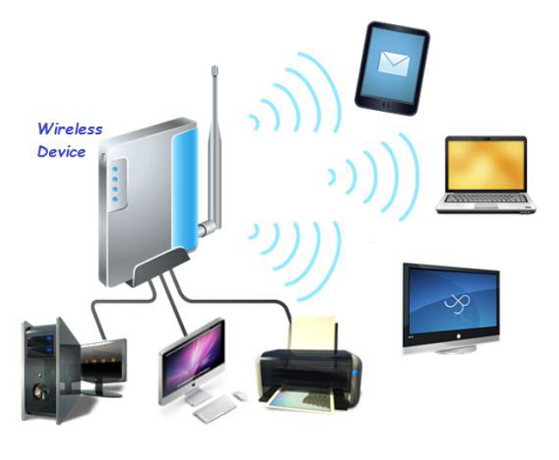
Some of the inherent characteristics of wireless communications systems which make it attractive for users, are given below −
Mobility − A wireless communications system allows users to access information beyond their desk and conduct business from anywhere without having a wire connectivity.
Reachability − Wireless communication systems enable people to be stay connected and be reachable, regardless of the location they are operating from.
Simplicity − Wireless communication system are easy and fast to deploy in comparison of cabled network. Initial setup cost could be a bit high but other advantages overcome that high cost.
Maintainability − In a wireless system, you do not have to spend too much cost and time to maintain the network setup.
Roaming Services − Using a wireless network system, you can provide service any where any time including train, buses, aeroplanes etc.
New Services − Wireless communication systems provide various smart services like SMS and MMS.
Wireless Network Topologies
There are basically three ways to set up a wireless network −
Point-to-point bridge
As you know, a bridge is used to connect two networks. A point-to-point bridge interconnects two buildings having different networks. For example, a wireless LAN bridge can interface with an Ethernet network directly to a particular access point (as shown in the following image).
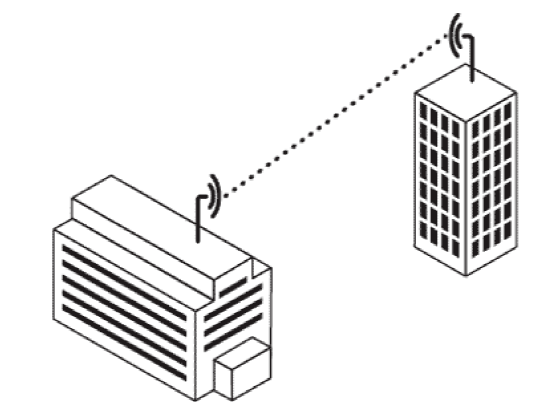
Point-to-multipoint bridge
This topology is used to connect three or more LANs that may be located on different floors in a building or across buildings(as shown in the following image).
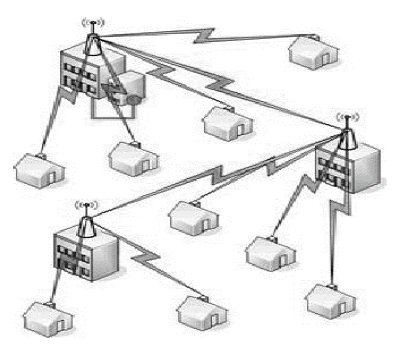
Mesh or ad hoc network
This network is an independent local area network that is not connected to a wired infrastructure and in which all stations are connected directly to one another(as shown in the following image).
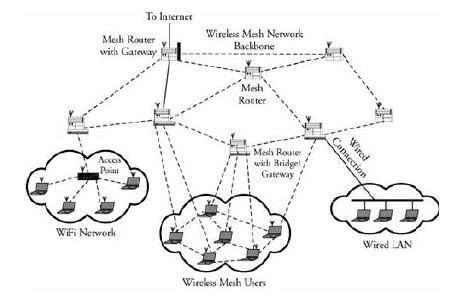
Wireless Technologies
Wireless technologies can be classified in different ways depending on their range. Each wireless technology is designed to serve a specific usage segment. The requirements for each usage segment are based on a variety of variables, including Bandwidth needs, Distance needs and Power.
Wireless Wide Area Network (WWAN)
This network enables you to access the Internet via a wireless wide area network (WWAN) access card and a PDA or laptop.
These networks provide a very fast data speed compared with the data rates of mobile telecommunications technology, and their range is also extensive. Cellular and mobile networks based on CDMA and GSM are good examples of WWAN.
Wireless Personal Area Network (WPAN)
These networks are very similar to WWAN except their range is very limited.
Wireless Local Area Network (WLAN)
This network enables you to access the Internet in localized hotspots via a wireless local area network (WLAN) access card and a PDA or laptop.
It is a type of local area network that uses high-frequency radio waves rather than wires to communicate between nodes.
These networks provide a very fast data speed compared with the data rates of mobile telecommunications technology, and their range is very limited. Wi-Fi is the most widespread and popular example of WLAN technology.
Wireless Metropolitan Area Network (WMAN)
This network enables you to access the Internet and multimedia streaming services via a wireless region area network (WRAN).
These networks provide a very fast data speed compared with the data rates of mobile telecommunication technology as well as other wireless network, and their range is also extensive.
Issues with Wireless Networks
There are following three major issues with Wireless Networks.
Quality of Service (QoS) − One of the primary concerns about wireless data delivery is that, unlike the Internet through wired services, QoS is inadequate. Lost packets and atmospheric interference are recurring problems of the wireless protocols.
Security Risk − This is another major issue with a data transfer over a wireless network. Basic network security mechanisms like the service set identifier (SSID) and Wireless Equivalency Privacy (WEP); these measures may be adequate for residences and small businesses, but they are inadequate for the entities that require stronger security.
Reachable Range − Normally, wireless network offers a range of about 100 meters or less. Range is a function of antenna design and power. Now a days the range of wireless is extended to tens of miles so this should not be an issue any more.
Wireless Broadband Access (WBA)
Broadband wireless is a technology that promises high-speed connection over the air. It uses radio waves to transmit and receive data directly to and from the potential users whenever they want it. Technologies such as 3G, Wi-Fi, WiMAX and UWB work together to meet unique customer needs.
WBA is a point-to-multipoint system which is made up of base station and subscriber equipment. Instead of using the physical connection between the base station and the subscriber, the base station uses an outdoor antenna to send and receive high-speed data and voice-to-subscriber equipment.
WBA offers an effective, complementary solution to wireline broadband, which has become globally recognized by a high percentage of the population.
What is Wi-Fi ?
Wi-Fi stands for Wireless Fidelity. Wi-Fi is based on the IEEE 802.11 family of standards and is primarily a local area networking (LAN) technology designed to provide in-building broadband coverage.
For more detail on Wi-Fi, please look into our Wi-Fi Tutorial.
WiMAX - What is WiMAX ?
WiMAX is one of the hottest broadband wireless technologies around today. WiMAX systems are expected to deliver broadband access services to residential and enterprise customers in an economical way.
Loosely, WiMax is a standardized wireless version of Ethernet intended primarily as an alternative to wire technologies (such as Cable Modems, DSL and T1/E1 links) to provide broadband access to customer premises.
More strictly, WiMAX is an industry trade organization formed by leading communications, component, and equipment companies to promote and certify compatibility and interoperability of broadband wireless access equipment that conforms to the IEEE 802.16 and ETSI HIPERMAN standards.
WiMAX would operate similar to WiFi, but at higher speeds over greater distances and for a greater number of users. WiMAX has the ability to provide service even in areas that are difficult for wired infrastructure to reach and the ability to overcome the physical limitations of traditional wired infrastructure.
WiMAX was formed in April 2001, in anticipation of the publication of the original 10-66 GHz IEEE 802.16 specifications. WiMAX is to 802.16 as the WiFi Alliance is to 802.11.
WiMAX is
Acronym for Worldwide Interoperability for Microwave Access.
Based on Wireless MAN technology.
A wireless technology optimized for the delivery of IP centric services over a wide area.
A scalable wireless platform for constructing alternative and complementary broadband networks.
A certification that denotes interoperability of equipment built to the IEEE 802.16 or compatible standard. The IEEE 802.16 Working Group develops standards that address two types of usage models −
- A fixed usage model (IEEE 802.16-2004).
- A portable usage model (IEEE 802.16e).
What is 802.16a ?
WiMAX is such an easy term that people tend to use it for the 802.16 standards and technology themselves, although strictly it applies only to systems that meet specific conformance criteria laid down by the WiMAX Forum.
The 802.16a standard for 2-11 GHz is a wireless metropolitan area network (MAN) technology that will provide broadband wireless connectivity to Fixed, Portable and Nomadic devices.
It can be used to connect 802.11 hot spots to the Internet, provide campus connectivity, and provide a wireless alternative to cable and DSL for last mile broadband access.
WiMax Speed and Range
WiMAX is expected to offer initially up to about 40 Mbps capacity per wireless channel for both fixed and portable applications, depending on the particular technical configuration chosen, enough to support hundreds of businesses with T-1 speed connectivity and thousands of residences with DSL speed connectivity. WiMAX can support voice and video as well as Internet data.
WiMax developed to provide wireless broadband access to buildings, either in competition to existing wired networks or alone in currently unserved rural or thinly populated areas. It can also be used to connect WLAN hotspots to the Internet. WiMAX is also intended to provide broadband connectivity to mobile devices. It would not be as fast as in these fixed applications, but expectations are for about 15 Mbps capacity in a 3 km cell coverage area.
With WiMAX, users could really cut free from today's Internet access arrangements and be able to go online at broadband speeds, almost wherever they like from within a MetroZone.
WiMAX could potentially be deployed in a variety of spectrum bands: 2.3GHz, 2.5GHz, 3.5GHz, and 5.8GHz
Why WiMax ?
WiMAX can satisfy a variety of access needs. Potential applications include extending broadband capabilities to bring them closer to subscribers, filling gaps in cable, DSL and T1 services, WiFi, and cellular backhaul, providing last-100 meter access from fibre to the curb and giving service providers another cost-effective option for supporting broadband services.
WiMAX can support very high bandwidth solutions where large spectrum deployments (i.e. >10 MHz) are desired using existing infrastructure keeping costs down while delivering the bandwidth needed to support a full range of high-value multimedia services.
WiMAX can help service providers meet many of the challenges they face due to increasing customer demands without discarding their existing infrastructure investments because it has the ability to seamlessly interoperate across various network types.
WiMAX can provide wide area coverage and quality of service capabilities for applications ranging from real-time delay-sensitive voice-over-IP (VoIP) to real-time streaming video and non-real-time downloads, ensuring that subscribers obtain the performance they expect for all types of communications.
WiMAX, which is an IP-based wireless broadband technology, can be integrated into both wide-area third-generation (3G) mobile and wireless and wireline networks allowing it to become part of a seamless anytime, anywhere broadband access solution.
Ultimately, WiMAX is intended to serve as the next step in the evolution of 3G mobile phones, via a potential combination of WiMAX and CDMA standards called 4G.
WiMAX Goals
A standard by itself is not enough to enable mass adoption. WiMAX has stepped forward to help solve barriers to adoption, such as interoperability and cost of deployment. WiMAX will help ignite the wireless MAN industry by defining and conducting interoperability testing and labeling vendor systems with a "WiMAX Certified™" label once testing has been completed successfully.
WiMAX & Wi-Fi Comparison
WiMAX is similar to the wireless standard known as Wi-Fi, but on a much larger scale and at faster speeds. A nomadic version would keep WiMAX-enabled devices connected over large areas, much like today’s cell phones. We can compare it with Wi-Fi based on the following factors.
IEEE Standards
Wi-Fi is based on IEEE 802.11 standard whereas WiMAX is based on IEEE 802.16. However, both are IEEE standards.
Range
Wi-Fi typically provides local network access for a few hundred feet with the speed of up to 54 Mbps, a single WiMAX antenna is expected to have a range of up to 40 miles with the speed of 70 Mbps or more. As such, WiMAX can bring the underlying Internet connection needed to service local Wi-Fi networks.
Scalability
Wi-Fi is intended for LAN applications, users scale from one to tens with one subscriber for each CPE device. Fixed channel sizes (20MHz).
WiMAX is designed to efficiently support from one to hundreds of Consumer premises equipments (CPE)s, with unlimited subscribers behind each CPE. Flexible channel sizes from 1.5MHz to 20MHz.
Bit rate
Wi-Fi works at 2.7 bps/Hz and can peak up to 54 Mbps in 20 MHz channel.
WiMAX works at 5 bps/Hz and can peak up to 100 Mbps in a 20 MHz channel.
Quality of Service
Wi-Fi does not guarantee any QoS but WiMax will provide your several level of QoS.
As such, WiMAX can bring the underlying Internet connection needed to service local Wi-Fi networks. Wi-Fi does not provide ubiquitous broadband while WiMAX does.
Comparison Table
| Freature | WiMax (802.16a) |
Wi-Fi (802.11b) |
Wi-Fi (802.11a/g) |
|---|---|---|---|
Primary Application |
Broadband Wireless Access |
Wireless LAN | Wireless LAN |
| Frequency Band | Licensed/Unlicensed 2 G to 11 GHz |
2.4 GHz ISM | 2.4 GHz ISM (g) 5 GHz U-NII (a) |
Channel Bandwidth |
Adjustable 1.25 M to 20 MHz |
25 MHz | 20 MHz |
| Half/Full Duplex | Full | Half | Half |
| Radio Technology | OFDM (256-channels) |
Direct Sequence Spread Spectrum |
OFDM (64-channels) |
Bandwidth Efficiency |
<=5 bps/Hz | <=0.44 bps/Hz | <=2.7 bps/Hz |
| Modulation | BPSK, QPSK, 16-, 64-, 256-QAM |
QPSK | BPSK, QPSK, 16-, 64-QAM |
| FEC | Convolutional Code Reed-Solomon |
None | Convolutional Code |
| Encryption | Mandatory- 3DES Optional- AES |
Optional- RC4 (AES in 802.11i) |
Optional- RC4 (AES in 802.11i) |
| Mobility | Mobile WiMax (802.16e) |
In development | In development |
| Mesh | Yes | Vendor Proprietary |
Vendor Proprietary |
| Access Protocol | Request/Grant | CSMA/CA | CSMA/CA |
WiMAX - Salient Features
WiMAX is a wireless broadband solution that offers a rich set of features with a lot of flexibility in terms of deployment options and potential service offerings. Some of the more salient features that deserve highlighting are as follows −
Two Type of Services
WiMAX can provide two forms of wireless service −
Non-line-of-sight − service is a WiFi sort of service. Here a small antenna on your computer connects to the WiMAX tower. In this mode, WiMAX uses a lower frequency range -- 2 GHz to 11 GHz (similar to WiFi).
Line-of-sight − service, where a fixed dish antenna points straight at the WiMAX tower from a rooftop or pole. The line-of-sight connection is stronger and more stable, so it's able to send a lot of data with fewer errors. Line-of-sight transmissions use higher frequencies, with ranges reaching a possible 66 GHz.
OFDM-based Physical Layer
The WiMAX physical layer (PHY) is based on orthogonal frequency division multiplexing, a scheme that offers good resistance to multipath, and allows WiMAX to operate in NLOS conditions.
Very High Peak Data Rates
WiMAX is capable of supporting very high peak data rates. In fact, the peak PHY data rate can be as high as 74Mbps when operating using a 20MHz wide spectrum.
More typically, using a 10MHz spectrum operating using TDD scheme with a 3:1 downlink-to-uplink ratio, the peak PHY data rate is about 25Mbps and 6.7Mbps for the downlink and the uplink, respectively.
Scalable Bandwidth and Data Rate Support
WiMAX has a scalable physical-layer architecture that allows for the data rate to scale easily with available channel bandwidth.
For example, a WiMAX system may use 128, 512, or 1,048-bit FFTs (fast fourier transforms) based on whether the channel bandwidth is 1.25MHz, 5MHz, or 10MHz, respectively. This scaling may be done dynamically to support user roaming across different networks that may have different bandwidth allocations.
Adaptive Modulation and Coding (AMC)
WiMAX supports a number of modulation and forward error correction (FEC) coding schemes and allows the scheme to be changed as per user and per frame basis, based on channel conditions.
AMC is an effective mechanism to maximize throughput in a time-varying channel.
Link-layer Retransmissions
WiMAX supports automatic retransmission requests (ARQ) at the link layer for connections that require enhanced reliability. ARQ-enabled connections require each transmitted packet to be acknowledged by the receiver; unacknowledged packets are assumed to be lost and are retransmitted.
Support for TDD and FDD
IEEE 802.16-2004 and IEEE 802.16e-2005 supports both time division duplexing and frequency division duplexing, as well as a half-duplex FDD, which allows for a low-cost system implementation.
WiMAX Uses OFDM
Mobile WiMAX uses Orthogonal frequency division multiple access (OFDM) as a multiple-access technique, whereby different users can be allocated different subsets of the OFDM tones.
Flexible and Dynamic per User Resource Allocation
Both uplink and downlink resource allocation are controlled by a scheduler in the base station. Capacity is shared among multiple users on a demand basis, using a burst TDM scheme.
Support for Advanced Antenna Techniques
The WiMAX solution has a number of hooks built into the physical-layer design, which allows for the use of multiple-antenna techniques, such as beamforming, space-time coding, and spatial multiplexing.
Quality-of-service Support
The WiMAX MAC layer has a connection-oriented architecture that is designed to support a variety of applications, including voice and multimedia services.
WiMAX system offers support for constant bit rate, variable bit rate, real-time, and non-real-time traffic flows, in addition to best-effort data traffic.
WiMAX MAC is designed to support a large number of users, with multiple connections per terminal, each with its own QoS requirement.
Robust Security
WiMAX supports strong encryption, using Advanced Encryption Standard (AES), and has a robust privacy and key-management protocol.
The system also offers a very flexible authentication architecture based on Extensible Authentication Protocol (EAP), which allows for a variety of user credentials, including username/password, digital certificates, and smart cards.
Support for Mobility
The mobile WiMAX variant of the system has mechanisms to support secure seamless handovers for delay-tolerant full-mobility applications, such as VoIP.
IP-based Architecture
The WiMAX Forum has defined a reference network architecture that is based on an all-IP platform. All end-to-end services are delivered over an IP architecture relying on IP-based protocols for end-to-end transport, QoS, session management, security, and mobility.
WiMAX - Building Blocks
A WiMAX system consists of two major parts −
- A WiMAX base station.
- A WiMAX receiver.
WiMAX Base Station
A WiMAX base station consists of indoor electronics and a WiMAX tower similar in concept to a cell-phone tower. A WiMAX base station can provide coverage to a very large area up to a radius of 6 miles. Any wireless device within the coverage area would be able to access the Internet.
The WiMAX base stations would use the MAC layer defined in the standard, a common interface that makes the networks interoperable and would allocate uplink and downlink bandwidth to subscribers according to their needs, on an essentially real-time basis.
Each base station provides wireless coverage over an area called a cell. Theoretically, the maximum radius of a cell is 50 km or 30 miles however, practical considerations limit it to about 10 km or 6 miles.
WiMAX Receiver
A WiMAX receiver may have a separate antenna or could be a stand-alone box or a PCMCIA card sitting in your laptop or computer or any other device. This is also referred as customer premise equipment (CPE).
WiMAX base station is similar to accessing a wireless access point in a WiFi network, but the coverage is greater.
Backhaul
A WiMAX tower station can connect directly to the Internet using a high-bandwidth, wired connection (for example, a T3 line). It can also connect to another WiMAX tower using a line-of-sight microwave link.
Backhaul refers both to the connection from the access point back to the base station and to the connection from the base station to the core network.
It is possible to connect several base stations to one another using high-speed backhaul microwave links. This would also allow for roaming by a WiMAX subscriber from one base station coverage area to another, similar to the roaming enabled by cell phones.
WiMAX - Reference Network Model
The IEEE 802.16e-2005 standard provides the air interface for WiMAX, but does not define the full end-to-end WiMAX network. The WiMAX Forum's Network Working Group (NWG) is responsible for developing the end-to-end network requirements, architecture, and protocols for WiMAX, using IEEE 802.16e-2005 as the air interface.
The WiMAX NWG has developed a network reference model to serve as an architecture framework for WiMAX deployments and to ensure interoperability among various WiMAX equipment and operators.
The network reference model envisions a unified network architecture for supporting fixed, nomadic, and mobile deployments and is based on an IP service model. Below is simplified illustration of an IP-based WiMAX network architecture. The overall network may be logically divided into three parts −
Mobile Stations (MS) used by the end user to access the network.
The access service network (ASN), which comprises one or more base stations and one or more ASN gateways that form the radio access network at the edge.
Connectivity service network (CSN), which provides IP connectivity and all the IP core network functions.
The network reference model developed by the WiMAX Forum NWG defines a number of functional entities and interfaces between those entities. The following figure shows some of the more important functional entities.
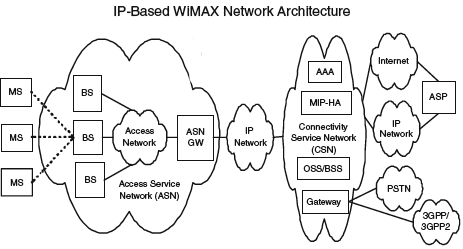
Base station (BS) − The BS is responsible for providing the air interface to the MS. Additional functions that may be part of the BS are micro mobility management functions, such as handoff triggering and tunnel establishment, radio resource management, QoS policy enforcement, traffic classification, DHCP (Dynamic Host Control Protocol) proxy, key management, session management, and multicast group management.
Access service network gateway (ASN-GW) − The ASN gateway typically acts as a layer 2 traffic aggregation point within an ASN. Additional functions that may be part of the ASN gateway include intra-ASN location management and paging, radio resource management, and admission control, caching of subscriber profiles, and encryption keys, AAA client functionality, establishment, and management of mobility tunnel with base stations, QoS and policy enforcement, foreign agent functionality for mobile IP, and routing to the selected CSN.
Connectivity service network (CSN) − The CSN provides connectivity to the Internet, ASP, other public networks, and corporate networks. The CSN is owned by the NSP and includes AAA servers that support authentication for the devices, users, and specific services. The CSN also provides per user policy management of QoS and security. The CSN is also responsible for IP address management, support for roaming between different NSPs, location management between ASNs, and mobility and roaming between ASNs.
The WiMAX architecture framework allows for the flexible decomposition and/or combination of functional entities when building the physical entities. For example, the ASN may be decomposed into base station transceivers (BST), base station controllers (BSC), and an ASNGW analogous to the GSM model of BTS, BSC, and Serving GPRS Support Node (SGSN).
WiMAX - Technology
WiMAX is a technology based on the IEEE 802.16 specifications to enable the delivery of last-mile wireless broadband access as an alternative to cable and DSL. The design of WiMAX network is based on the following major principles −
Spectrum − able to be deployed in both licensed and unlicensed spectra.
Topology − supports different Radio Access Network (RAN) topologies.
Interworking − independent RAN architecture to enable seamless integration and interworking with WiFi, 3GPP and 3GPP2 networks and existing IP operator core network.
IP connectivity − supports a mix of IPv4 and IPv6 network interconnects in clients and application servers.
Mobility management − possibility to extend the fixed access to mobility and broadband multimedia services delivery.
WiMAX has defined two MAC system profiles the basic ATM and the basic IP. They have also defined two primary PHY system profiles, the 25 MHz-wide channel for use in (US deployments) the 10.66 GHz range, and the 28 MHz wide channel for use in (European deployments) the 10.66 GHz range.
WiMAX Physical and MAC Layers are explained in separate chapters of this tutorial.
The WiMAX technical working group is defining MAC and PHY system profiles for IEEE 802.16a and HiperMan standards. The MAC profile includes an IP-based version for both wireless MAN (licensed) and wireless HUMAN (licence-exempt).
IEEE Standard 802.16 was designed to evolve as a set of air interfaces standards for WMAN based on a common MAC protocol, but with physical layer specifications dependent on the spectrum of use and the associated regulations.
The WiMAX framework is based on several core principles −
Support for different RAN topologies.
Well-defined interfaces to enable 802.16 RAN architecture independence while enabling seamless integration and interworking with WiFi, 3GPP3 and 3GPP2 networks.
Leverage and open, IETF-defined IP technologies to build scalable all-IP 802.16 access networks using common off the shelf (COTS) equipment.
Support for IPv4 and IPv6 clients and application servers, recommending use of IPv6 in the infrastructure.
Functional extensibility to support future migration to full mobility and delivery of rich broadband multimedia.
WiMAX - Physical Layer
The WiMAX physical layer is based on orthogonal frequency division multiplexing. OFDM is the transmission scheme of choice to enable high-speed data, video, and multimedia communications and is used by a variety of commercial broadband systems, including DSL, Wi-Fi, Digital Video Broadcast-Handheld (DVB-H), and MediaFLO, besides WiMAX.
OFDM is an elegant and efficient scheme for high data rate transmission in a non-line-of-sight or multipath radio environment.
Adaptive Modulation and Coding in WiMAX
WiMAX supports a variety of modulation and coding schemes and allows for the scheme to change on a burst-by-burst basis per link, depending on channel conditions. Using the channel quality feedback indicator, the mobile can provide the base station with feedback on the downlink channel quality. For the uplink, the base station can estimate the channel quality, based on the received signal quality.
The following table provides a list of the various modulation and coding schemes supported by WiMAX −
| Downlink | Uplink | |
|---|---|---|
| Modulation | BPSK, QPSK, 16 QAM, 64 QAM; BPSK optional for OFDMA-PHY | BPSK, QPSK, 16 QAM; 64 QAM optional |
| Coding | Mandatory: convolutional codes at rate 1/2, 2/3, 3/4, 5/6 Optional: convolutional turbo codes at rate 1/2, 2/3, 3/4, 5/6; repetition codes at rate 1/2, 1/3, 1/6, LDPC, RS-Codes for OFDM-PHY |
Mandatory: convolutional codes at rate 1/2, 2/3, 3/4, 5/6 Optional: convolutional turbo codes at rate 1/2, 2/3, 3/4, 5/6; repetition codes at rate 1/2, 1/3, 1/6, LDPC |
PHY-Layer Data Rates
Because the physical layer of WiMAX is quite flexible, data rate performance varies based on the operating parameters. Parameters that have a significant impact on the physical-layer data rate are channel bandwidth and the modulation and coding scheme used. Other parameters, such as number of sub-channels, OFDM guard time, and oversampling rate, also have an impact.
Following is the PHY-layer data rate at various channel bandwidths, as well as modulation and coding schemes.
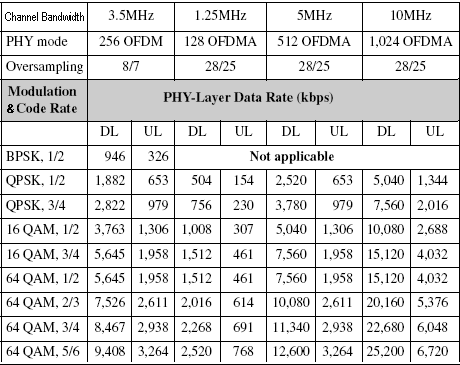
WiMAX - OFDM Basics
OFDM belongs to a family of transmission schemes called multicarrier modulation, which is based on the idea of dividing a given high-bit-rate data stream into several parallel lower bit-rate streams and modulating each stream on separate carriers, often called subcarriers or tones.
Multicarrier modulation schemes eliminate or minimize inter-symbol interference (ISI) by making the symbol time large enough so that the channel-induced delays are an insignificant (typically, < 10 percent) fraction of the symbol duration.
Therefore, in high-data-rate systems in which the symbol duration is small, being inversely proportional to the data rate splitting the data stream into many parallel streams increases the symbol duration of each stream such that the delay spread is only a small fraction of the symbol duration.
OFDM is a spectrally efficient version of multicarrier modulation, where the subcarriers are selected such that they are all orthogonal to one another over the symbol duration, thereby avoiding the need to have non-overlapping subcarrier channels to eliminate inter-carrier interference.
In order to completely eliminate ISI, guard intervals are used between OFDM symbols. By making the guard interval larger than the expected multipath delay spread, ISI can be completely eliminated. Adding a guard interval, however, implies power wastage and a decrease in bandwidth efficiency.
WiMAX - MAC Layer
The IEEE 802.16 MAC was designed for point-to-multipoint broadband wireless access applications. The primary task of the WiMAX MAC layer is to provide an interface between the higher transport layers and the physical layer.
The MAC layer takes packets from the upper layer, these packets are called MAC service data units (MSDUs) and organizes them into MAC protocol data units (MPDUs) for transmission over the air. For received transmissions, the MAC layer does the reverse.
The IEEE 802.16-2004 and IEEE 802.16e-2005 MAC design includes a convergence sublayer that can interface with a variety of higher-layer protocols, such as ATM TDM Voice, Ethernet, IP, and any unknown future protocol.
The 802.16 MAC is designed for point-to-multipoint (PMP) applications and is based on collision sense multiple access with collision avoidance (CSMA/CA).
The MAC incorporates several features suitable for a broad range of applications at different mobility rates, such as the following −
Privacy key management (PKM) for MAC layer security. PKM version 2 incorporates support for extensible authentication protocol (EAP).
Broadcast and multicast support.
Manageability primitives.
High-speed handover and mobility management primitives.
Three power management levels, normal operation, sleep, and idle.
Header suppression, packing and fragmentation for an efficient use of spectrum.
Five service classes, unsolicited grant service (UGS), real-time polling service (rtPS), non-real-time polling service (nrtPS), best effort (BE), and Extended real-time variable rate (ERT-VR) service.
These features combined with the inherent benefits of scalable OFDMA make 802.16 suitable for high-speed data and bursty or isochronous IP multimedia applications.
Support for QoS is a fundamental part of the WiMAX MAC-layer design. WiMAX borrows some of the basic ideas behind its QoS design from the DOCSIS cable modem standard.
Strong QoS control is achieved by using a connection-oriented MAC architecture, where all downlink and uplink connections are controlled by the serving BS.
WiMAX also defines a concept of a service flow. A service flow is a unidirectional flow of packets with a particular set of QoS parameters and is identified by a service flow identifier (SFID).
WiMAX - Mobility Support
WiMAX envisions four mobility-related usage scenarios −
Nomadic − The user is allowed to take a fixed subscriber station and reconnect from a different point of attachment.
Portable − Nomadic access is provided to a portable device, such as a PC card, with expectation of a best-effort handover.
Simple mobility − The subscriber may move at speeds up to 60 kmph with brief interruptions (less than 1 sec) during handoff.
Full mobility − Up to 120 kmph mobility and seamless handoff (less than 50 ms latency and < 1% packet loss) is supported.
It is likely that WiMAX networks will initially be deployed for fixed and nomadic applications and then evolve to support portability to full mobility over time.
The IEEE 802.16e-2005 standard defines a framework for supporting mobility management. In particular, the standard defines signaling mechanisms for tracking subscriber stations as they move from the coverage range of one base station to another when active or as they move from one paging group to another when idle.
The standard also has protocols to enable a seamless handover of ongoing connections from one base station to another.
The standard also has protocols to enable a seamless handover of ongoing connections from one base station to another. The WiMAX Forum has used the framework defined in IEEE 802.16e-2005, to further develop mobility management within an end-to-end network architecture framework. The architecture also supports IP-layer mobility using mobile IP.
WiMAX - Security Functions
WiMAX systems were designed at the outset with robust security in mind. The standard includes state-of-the-art methods for ensuring user data privacy and preventing unauthorized access with additional protocol optimization for mobility.
Security is handled by a privacy sublayer within the WiMAX MAC. The key aspects of WiMAX security are as follow −
Support for Privacy
User data is encrypted using cryptographic schemes of proven robustness to provide privacy. Both AES (Advanced Encryption Standard) and 3DES (Triple Data Encryption Standard) are supported.
The 128-bit or 256-bit key used for deriving the cipher is generated during the authentication phase and is periodically refreshed for additional protection.
Device/user Authentication
WiMAX provides a flexible means for authenticating subscriber stations and users to prevent unauthorized use. The authentication framework is based on the Internet Engineering Task Force (IETF) EAP, which supports a variety of credentials, such as username/password, digital certificates, and smart cards.
WiMAX terminal devices come with built-in X.509 digital certificates that contain their public key and MAC address. WiMAX operators can use the certificates for device authentication and use a username/password or smart card authentication on top of it for user authentication.
Flexible Key-management Protocol
The Privacy and Key Management Protocol Version 2 (PKMv2) is used for securely transferring keying material from the base station to the mobile station, periodically re-authorizing and refreshing the keys.
Protection of Control Messages
The integrity of over-the-air control messages is protected by using message digest schemes, such as AES-based CMAC or MD5-based HMAC.
Support for Fast Handover
To support fast handovers, WiMAX allows the MS to use pre-authentication with a particular target BS to facilitate accelerated re-entry.
A three-way handshake scheme is supported to optimize the re-authentication mechanisms for supporting fast handovers, while simultaneously preventing any man-in-the-middle attacks.
WiMAX - IEEE Standards
The IEEE 802.16, the Air Interface for Fixed Broadband Wireless Access Systems, also known as the IEEE WirelessMAN air interface, is an emerging suite of standards for fixed, portable and mobile BWA in MAN.
These standards are issued by IEEE 802.16 work group that originally covered the wireless local loop (WLL) technologies in the 10.66 GHz radio spectrum, which were later extended through amendment projects to include both licensed and unlicensed spectra from 2 to 11 GHz.
The WiMAX umbrella currently includes 802.16-2004 and 802.16e. 802.16-2004 utilizes OFDM to serve multiple users in a time division fashion in a sort of a round-robin technique, but done extremely quickly so that users have the perception that they are always transmitting/receiving. 802.16e utilizes OFDMA and can serve multiple users simultaneously by allocating sets of tones to each user.
Following is the chart of various IEEE 802.16 Standards related to WiMAX.
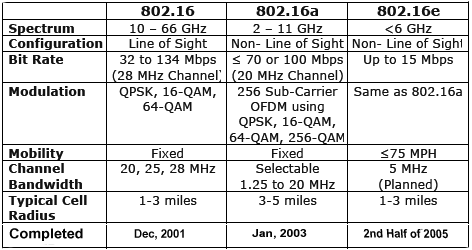
NOTE − The IEEE 802.16 standards for BWA provide the possibility for interoperability between equipment from different vendors, which is in contrast to the previous BWA industry, where proprietary products with high prices are dominant in the market.
WiMAX - WiMAXForum™
A nonprofit organization called WiMAX Forum™ was formed in 2001, with the aim of harmonizing standards, testing and certifying interoperability between equipment from different manufacturers.
WiMAX Forum™ was formed by equipment and component suppliers to support the IEEE 802.16 BWA system by helping to ensure the compatibility and interoperability of BWA equipment, which will lead to lower cost through chip-level implementation.
WiMAX Forum™ is doing what WiFi Alliance has done for wireless LAN and IEEE 802.11. WiMAX Forum Certified™ products adhere to the IEEE 802.16 standard and offer higher bandwidth, lower costs, and broader service capabilities than most of the available proprietary solutions.
The WiMAX Forum™ is working on setting up a baseline protocol that allows equipment and devices from multiple vendors to interoperate and also provides a choice of equipment and devices from different suppliers.
Members of WiMAXForum
The WiMAX Forum™ has more than 400 members from equipment manufacturers, semiconductor suppliers, and services providers, and membership was recently opened for content providers. Some of the noted members are Alcatel, AT&T, Fujitsu, Intel, Nortel, Motorola, SBC, and Siemens.
WiMAX - Summary
We have covered just the very basics of WiMAX in this tutorial. There is plenty of good reference material available out there that you should refer to become a master of WiMAX. Please check WiMAX Useful Resources chapter of this tutorial for more information on WiMAX.
Here is a quick recapitulation of the points that we discussed in this tutorial −
WiMAX is based on a very flexible and robust air interface defined by the IEEE 802.16 group.
WiMAX is similar to the wireless standard known as Wi-Fi, but on a much larger scale and at faster speeds.
The WiMAX physical layer is based on OFDM, which is an elegant and effective technique for overcoming multipath distortion.
The physical layer supports several advanced techniques for increasing the reliability of the link layer. These techniques include powerful error correction coding, including turbo coding and LDPC, hybrid-ARQ, and antenna arrays.
WiMAX supports a number of advanced signal-processing techniques to improve overall system capacity. These techniques include adaptive modulation and coding, spatial multiplexing, and multiuser diversity.
WiMAX has a very flexible MAC layer that can accommodate a variety of traffic types, including voice, video, and multimedia, and provide strong QoS.
Robust security functions, such as strong encryption and mutual authentication, are built into the WiMAX standard.
WiMAX defines a flexible all-IP-based network architecture that allows for the exploitation of all the benefits of IP.
WiMAX offers very high spectral efficiency, particularly when using higher-order MIMO solutions.
WiMAX Forum™ is an industry-led, non-profit corporation formed to promote and certify compatibility and interoperability of broadband wireless products.
WiMAX Forum Certified™ products are based on a single global standard IEEE 802.16 enabling complete interoperability worldwide.
What is Next?
IEEE 802.16 products are in the final phases of commercial development with initial trial deployments already underway. So be ready for a new wireless revolutionary phase.
You might be interested to know more about WiMAX. So please check WiMAX Useful Resources.
Send me your feedback at webmaster@tutorialspoint.com Thanks.